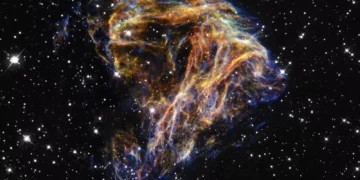The Large Magellanic Cloud (LMC), a dwarf galaxy neighboring our Milky Way, has long been viewed as a relatively uneventful cosmic companion. However, recent findings suggest that this galaxy may harbor something completely unexpected—a supermassive black hole (SMBH). This discovery, if confirmed, would challenge established astrophysical theories, as SMBHs have traditionally been associated with much larger galaxies.
The Case of the Hypervelocity Stars
The key evidence suggesting the presence of an SMBH in the LMC is the existence of hypervelocity stars. Typically, stars orbit their galaxies at relatively moderate speeds, averaging around 100 kilometers per second. However, some stars move at speeds up to ten times faster. These high-velocity stars are rare, but they have been observed being ejected from the Milky Way’s center due to the influence of its SMBH.
Now, researchers have found at least 21 hypervelocity stars in the Milky Way whose origins are difficult to explain through the activity of Sagittarius A*. Instead, simulations suggest these stars could have originated in the LMC, indicating a massive gravitational force at its center capable of launching them across the cosmos.
This aligns with a well-established astrophysical concept known as the Hills Mechanism, which describes how black holes can interact with binary star systems. If a binary system gets too close to a black hole, one star is captured, while the other is violently ejected at extreme speeds. This is likely what’s happening in the LMC—if it indeed harbors an SMBH.
Why Is This Discovery So Important?
1. Challenging Existing Theories of Galactic Evolution
Until now, the standard model of galaxy formation held that SMBHs only form in large galaxies. The reasoning was that supermassive black holes grow by consuming gas and merging with other black holes over billions of years. However, if a supermassive black hole exists in the LMC, it suggests that SMBHs can form in dwarf galaxies as well.
This would mean that the formation of SMBHs could be more common than we thought, with smaller galaxies possibly nurturing these cosmic giants before they merge into larger structures. If confirmed, this discovery would force astrophysicists to rethink the criteria for SMBH formation and the role of dwarf galaxies in the broader cosmic landscape.
2. New Insights into the Fate of the LMC and the Milky Way
The LMC is currently in orbit around the Milky Way and is expected to collide with our galaxy in about 2.4 billion years. Understanding whether it contains an SMBH could provide critical insights into how this future galactic merger will unfold.
If an SMBH is present in the LMC, it could interact with Sagittarius A*, potentially leading to intense gravitational disturbances, increased star formation, and even the merging of two supermassive black holes. This, in turn, could produce massive gravitational waves, the kind detected by observatories such as LIGO and Virgo.
What Do Scientists Plan to Do Next?
While the hypervelocity stars provide strong indirect evidence, confirming the existence of an SMBH in the LMC will require more observational data. Here’s how astronomers plan to investigate further:
- Using the James Webb Space Telescope (JWST) and Gaia
- The European Space Agency’s Gaia mission has been mapping millions of stars and tracking their movement across the sky. If more hypervelocity stars are traced back to the LMC, the case for an SMBH will strengthen.
- The JWST could detect emissions from material falling into the suspected black hole, providing direct observational evidence.
- Radio and X-ray Observations
- Supermassive black holes often emit X-rays as they consume gas and dust. Observatories like Chandra and XMM-Newton will scan the LMC for any X-ray activity that could be linked to an accretion disk around the SMBH.
- Radio telescopes, such as the Very Large Array (VLA), may detect jets emitted from the suspected black hole’s poles.
- Gravitational Wave Observations
- If the LMC’s SMBH merges with the Milky Way’s Sagittarius A*, the resulting event would send out powerful gravitational waves. Future detectors, such as the Laser Interferometer Space Antenna (LISA), could detect these waves and confirm the presence of the SMBH.
Could There Be Another Explanation?
While the presence of an SMBH in the LMC is the most exciting explanation, scientists are considering alternative theories. Other possible causes for the hypervelocity stars include:
- Supernova Explosions: If a massive star in the LMC went supernova, the resulting explosion could propel nearby stars outward at high speeds. However, this mechanism is unlikely to account for all the observed hypervelocity stars.
- Interactions with Other Galaxies: The LMC is part of a larger structure, the Magellanic System, which includes the Small Magellanic Cloud. Gravitational interactions between these galaxies could, in theory, eject stars, but again, this does not fully explain the observed speeds.
Ultimately, the most plausible explanation remains the presence of an SMBH. However, until direct evidence is found, astronomers will continue exploring all possibilities.
Conclusion: A Paradigm Shift in Black Hole Science?
The potential discovery of a supermassive black hole in the Large Magellanic Cloud could revolutionize our understanding of galaxy evolution and black hole formation. It challenges the long-held belief that SMBHs only exist in large galaxies, suggesting that even smaller ones can host these cosmic behemoths.
Reference:
Hypervelocity Stars Trace a Supermassive Black Hole in the Large Magellanic Cloud



















